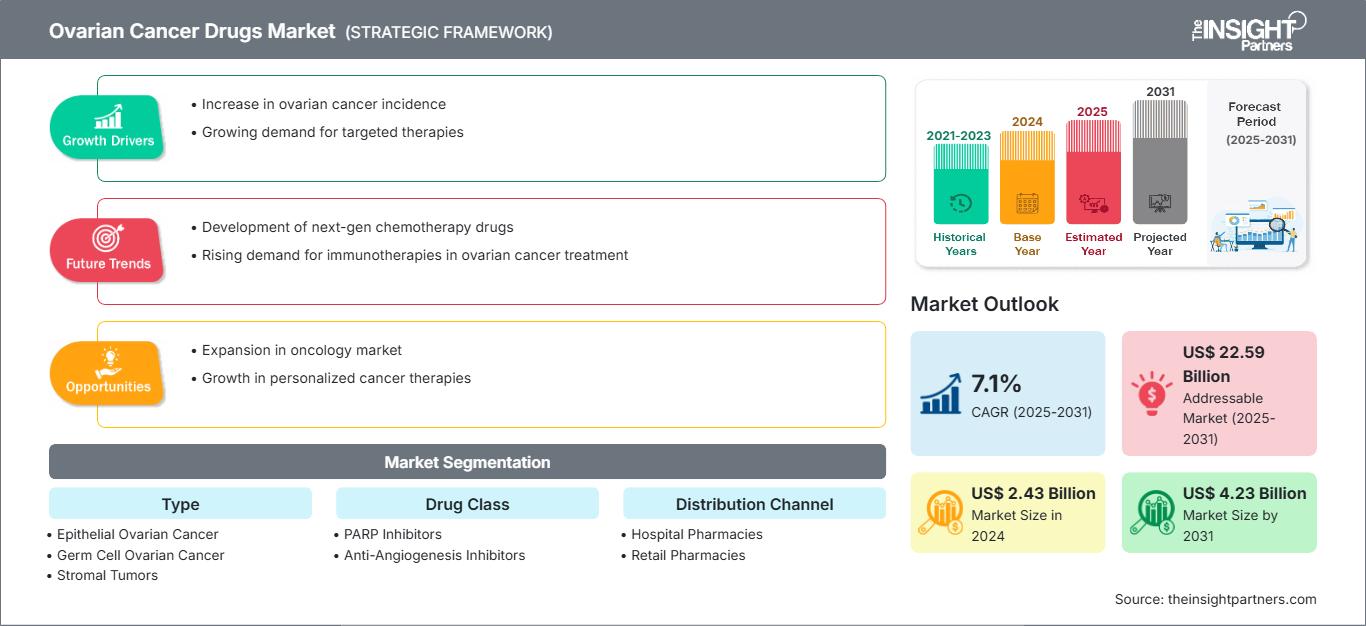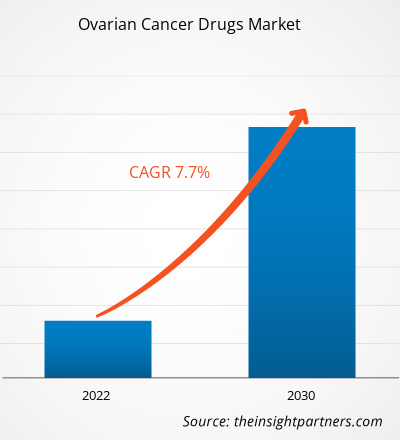Der Markt für Medikamente gegen Eierstockkrebs soll von 2,43 Milliarden US-Dollar im Jahr 2024 auf 4,23 Milliarden US-Dollar im Jahr 2031 wachsen; für den Markt wird zwischen 2025 und 2031 eine durchschnittliche jährliche Wachstumsrate (CAGR) von 7,1 % erwartet.
Markteinblicke und Analystenmeinung:
Die steigende Zahl von Eierstockkrebserkrankungen treibt das Wachstum des Marktes für Medikamente gegen Eierstockkrebs voran. Produktrückrufe aufgrund von Nebenwirkungen behindern jedoch das Marktwachstum.
Wachstumstreiber:
Steigende Fälle von Eierstockkrebs steigern die Nachfrage nach Therapieoptionen
Eierstockkrebs ist die siebthäufigste Krebserkrankung bei Frauen und die dritthäufigste gynäkologische Krebserkrankung nach Gebärmutterhalskrebs und Endometriumkarzinom (Gebärmutterkrebs). Laut dem Bericht der World Ovarian Cancer Coalition wird jährlich bei 324.000 Frauen Eierstockkrebs diagnostiziert, und 207.000 Frauen sterben an der Krankheit. Darüber hinaus wird bei der Mehrheit der Patientinnen mit Eierstockkrebs ein fortgeschrittenes Stadium (lokal fortgeschritten oder metastasiert) diagnostiziert, da es kein öffentliches Gesundheitsscreening-Programm zur Früherkennung von Eierstockkrebs gibt. Daher treibt die steigende Zahl von Eierstockkrebserkrankungen die Nachfrage nach wirksamen Therapieoptionen voran. Die Erstlinientherapie mit einer Kombination aus Debulking-Operation und platinbasierter Chemotherapie ist die Standardbehandlung für Frauen mit neu diagnostiziertem fortgeschrittenem Eierstockkrebs. Darüber hinaus stellen Therapieoptionen wie die zugelassenen PARP-Inhibitoren Olaparib, Rucaparib und Niraparib bahnbrechende Optionen für die Behandlung von neu diagnostiziertem Eierstockkrebs dar. Der Einsatz von PARP-Inhibitoren in der Behandlung von fortgeschrittenem Eierstockkrebs hat sich zudem als wirksame Therapieoption zur Verbesserung der klinischen Ergebnisse erwiesen. Diese Inhibitoren bieten langfristige Wirksamkeit und progressionsfreies Überleben (PFS) in den neu diagnostizierten Fällen nach einem vollständigen Ansprechen (CR) auf die erste, zweite und dritte platinbasierte Chemotherapie.
Passen Sie diesen Bericht Ihren Anforderungen an
Sie erhalten kostenlos Anpassungen an jedem Bericht, einschließlich Teilen dieses Berichts oder einer Analyse auf Länderebene, eines Excel-Datenpakets sowie tolle Angebote und Rabatte für Start-ups und Universitäten.
Markt für Medikamente gegen Eierstockkrebs: Strategische Einblicke

-
Holen Sie sich die wichtigsten Markttrends aus diesem Bericht.Dieses KOSTENLOSE Beispiel umfasst Datenanalysen, die von Markttrends bis hin zu Schätzungen und Prognosen reichen.
Segmentierung und Umfang des Berichts:
Die Marktanalyse für Medikamente gegen Eierstockkrebs wurde unter Berücksichtigung der folgenden Segmente durchgeführt: Typ, Medikamentenklasse und Vertriebskanal.
Segmentanalyse:
Nach Typ ist der Markt in epitheliales Eierstockkarzinom, Keimzell-Eierstockkarzinom und Stromatumoren segmentiert. Das Segment epitheliales Eierstockkarzinom hatte 2022 den größten Marktanteil bei Medikamenten gegen Eierstockkrebs; für dasselbe Segment wird im Prognosezeitraum die höchste durchschnittliche jährliche Wachstumsrate von 8,2 % erwartet. Laut dem Bericht von Cancer Research UK ist epitheliales Eierstockkarzinom die häufigste Art von Eierstockkrebs. Beispielsweise sind fast 90 von 100 Tumoren des Eierstocks (90 %) epitheliale Tumoren. Für Patientinnen mit aggressivem Eierstockkrebs im Spätstadium stehen auf dem Markt nur begrenzte Behandlungsmöglichkeiten zur Verfügung. Im November 2022 gab die Food and Drug Administration (FDA) die Zulassung für „Mirvetuximab Soravtansine-Gynx“ des Herstellers Elahere ImmunoGen, Inc. für erwachsene Patientinnen mit epithelialem Eierstockkrebs bekannt. Die ärztlich empfohlene Dosis dieses Medikamentenkandidaten zur Behandlung von epithelialem Eierstockkrebs beträgt 6 mg/kg und wird alle drei Wochen als intravenöse Infusion verabreicht. Im Januar 2024 gab die FDA die Zulassung für den Fast-Track-Status (FTD) für „RC88“ bekannt, ein gegen Mesothelin gerichtetes Antikörper-Wirkstoff-Konjugat (ADC) zur Behandlung von Patientinnen mit rezidivierendem epithelialem Eierstockkrebs. Somit treibt die steigende Zahl von Medikamentenzulassungen den Markt für Eierstockkrebsmedikamente im Segment des epithelialen Eierstockkrebses voran.
Markttrends bei Eierstockkrebsmedikamenten
Kombinationstherapie
Mehrere medizinische Forschungsinstitute entwickeln neuartige Kombinationsmedikamente zur Behandlung von Eierstockkrebs. Im September 2023 kündigten Forscher am Royal Marsden eine neue Kombinationstherapie an, die sich bei Patientinnen mit fortgeschrittenem Eierstockkrebs als wirksam erweist. Die Forscher testeten die Kombinationstherapie auf ihre Wirkung bei niedriggradigem serösem Eierstockkrebs (LGSOC), einer seltenen Form von Eierstockkrebs mit geringer Ansprechrate auf Behandlungen. In der klinischen Studie RAMP-201 wurde das Medikament Avutometinib mit Defactinib kombiniert, um deren synergistische therapeutische Wirkung bei Patientinnen mit LGSOC zu untersuchen. Die vorläufigen Ergebnisse der klinischen Studie zeigen, dass bei 45 % der mit der Medikamentenkombination behandelten Patientinnen eine signifikante Tumorschrumpfung eintrat. Solche zufriedenstellenden klinischen Ergebnisse mit der Kombinationstherapie sind fast doppelt so wirksam wie mit Trametinib, einem in England erhältlichen Medikament zur zielgerichteten Therapie, das eine Ansprechrate von nur 26 % aufweist. Im Januar 2024 gab die FDA die Zulassung für das Kombinationspräparat SH-105 zur Behandlung von Patientinnen mit Brust- und Eierstockkrebs bekannt. Kombinationstherapien zeichnen sich somit als neue Trends ab, die das Marktwachstum für Medikamente gegen Eierstockkrebs in den kommenden Jahren wahrscheinlich ankurbeln werden.
Regionale Analyse:
Der Bericht zum Markt für Medikamente gegen Eierstockkrebs umfasst Nordamerika, Europa, den asiatisch-pazifischen Raum, Süd- und Mittelamerika sowie den Nahen Osten und Afrika. Im Jahr 2022 hatte Nordamerika den größten Marktanteil bei Medikamenten gegen Eierstockkrebs. Das Marktwachstum in dieser Region wird durch die steigende Zahl von Produkteinführungen führender Unternehmen und die Präsenz wichtiger Marktakteure vorangetrieben. Die USA leisten den größten Beitrag zum nordamerikanischen Markt. Die steigende Zahl von Eierstockkrebserkrankungen bei Frauen zwingt Unternehmen und Aufsichtsbehörden dazu, innovative Medikamente in dieser Region zu entwickeln und zuzulassen. Auch die steigende Zahl von Auftragsforschungsinstituten (CROs) begünstigt das Wachstum des Marktes für Eierstockkrebsmedikamente in Nordamerika.
Medikamente gegen Eierstockkrebs
Regionale Einblicke in den Markt für EierstockkrebsmedikamenteDie Analysten von The Insight Partners haben die regionalen Trends und Faktoren, die den Markt für Eierstockkrebsmedikamente im Prognosezeitraum beeinflussen, ausführlich erläutert. In diesem Abschnitt werden auch die Marktsegmente und die geografische Lage von Eierstockkrebsmedikamenten in Nordamerika, Europa, im asiatisch-pazifischen Raum, im Nahen Osten und Afrika sowie in Süd- und Mittelamerika erörtert.
Umfang des Marktberichts zu Medikamenten gegen Eierstockkrebs
Dichte der Marktteilnehmer auf dem Gebiet der Eierstockkrebsmedikamente: Verständnis ihrer Auswirkungen auf die Geschäftsdynamik
Der Markt für Eierstockkrebsmedikamente wächst rasant. Die steigende Nachfrage der Endverbraucher ist auf Faktoren wie veränderte Verbraucherpräferenzen, technologische Fortschritte und ein stärkeres Bewusstsein für die Produktvorteile zurückzuführen. Mit der steigenden Nachfrage erweitern Unternehmen ihr Angebot, entwickeln Innovationen, um den Bedürfnissen der Verbraucher gerecht zu werden, und nutzen neue Trends, was das Marktwachstum weiter ankurbelt.

- Holen Sie sich die Markt für Medikamente gegen Eierstockkrebs Übersicht der wichtigsten Akteure
Branchenentwicklungen und zukünftige Chancen:
Die Marktprognose für Medikamente gegen Eierstockkrebs kann den Akteuren in diesem Markt bei der Planung ihrer Wachstumsstrategien helfen. Im Folgenden sind einige strategische Entwicklungen führender Akteure auf dem Markt aufgeführt:
- Im November 2022 erhielt ImmunoGen die FDA-Zulassung für ELAHERE (Mirvetuximab Soravtansine-Gynx) zur Behandlung erwachsener Patienten mit platinresistentem epithelialem Eierstockkrebs. ELAHERE ist speziell für Patientinnen mit FRα-positivem, platinresistentem Eierstockkrebs zugelassen, einer Erkrankung, die aufgrund der begrenzten Verfügbarkeit von Behandlungsmöglichkeiten und der schlechten klinischen Ergebnisse der bestehenden Therapeutika eine Herausforderung darstellt.
Wettbewerbslandschaft und wichtige Unternehmen:
Elli Lilly, AstraZeneca, GSK, Zielab, ImmunoGen (AbbVie), GeneTech (Roche), Vivesto, Allarity Therapeutics, Inc., Aeterna Zentaris und Luye Pharma gehören zu den namhaften Unternehmen, die im Marktbericht für Eierstockkrebsmedikamente vorgestellt werden. Diese Unternehmen konzentrieren sich auf die Entwicklung neuer Technologien, die Verbesserung bestehender Produkte und die Ausweitung ihrer geografischen Präsenz, um der weltweit wachsenden Verbrauchernachfrage gerecht zu werden.
- Historische Analyse (2 Jahre), Basisjahr, Prognose (7 Jahre) mit CAGR
- PEST- und SWOT-Analyse
- Marktgröße Wert/Volumen – Global, Regional, Land
- Branchen- und Wettbewerbslandschaft
- Excel-Datensatz
Aktuelle Berichte
Verwandte Berichte
Erfahrungsberichte
Grund zum Kauf
- Fundierte Entscheidungsfindung
- Marktdynamik verstehen
- Wettbewerbsanalyse
- Kundeneinblicke
- Marktprognosen
- Risikominimierung
- Strategische Planung
- Investitionsbegründung
- Identifizierung neuer Märkte
- Verbesserung von Marketingstrategien
- Steigerung der Betriebseffizienz
- Anpassung an regulatorische Trends






















 Kostenlose Probe anfordern für - Markt für Medikamente gegen Eierstockkrebs
Kostenlose Probe anfordern für - Markt für Medikamente gegen Eierstockkrebs